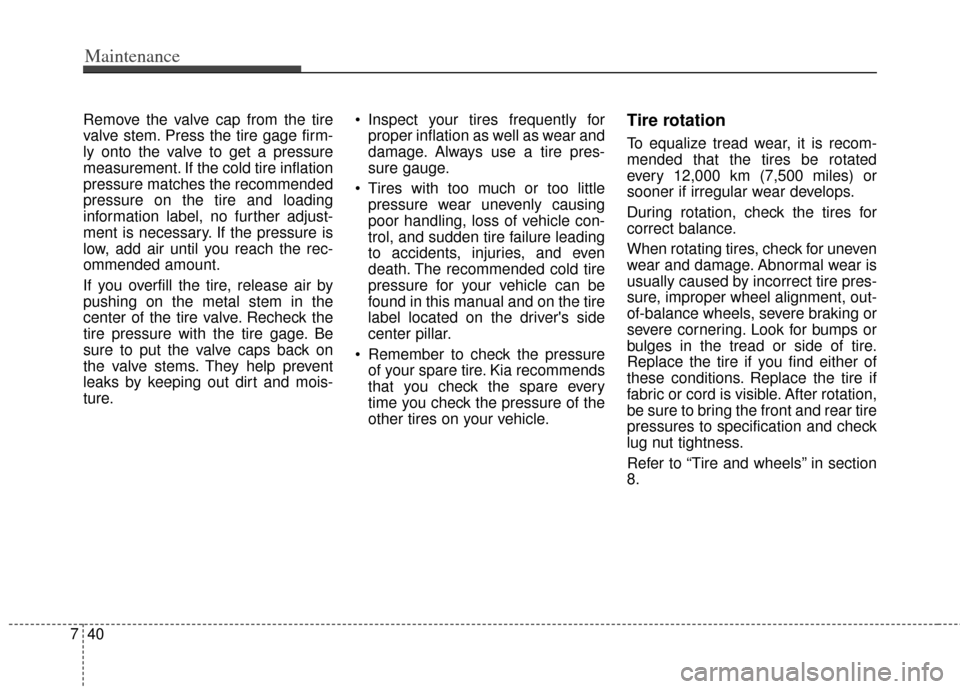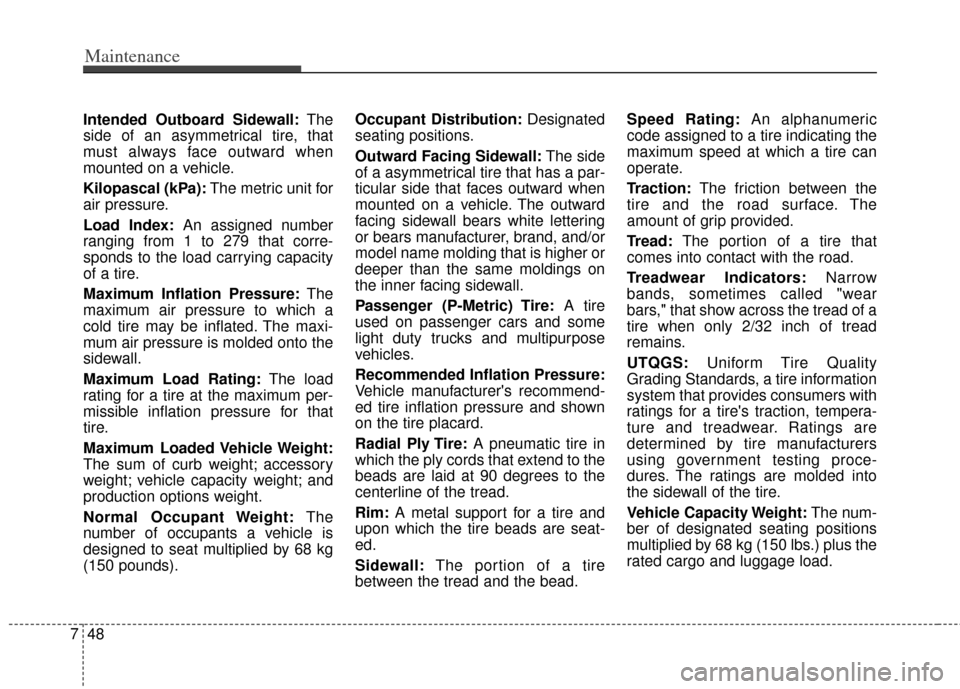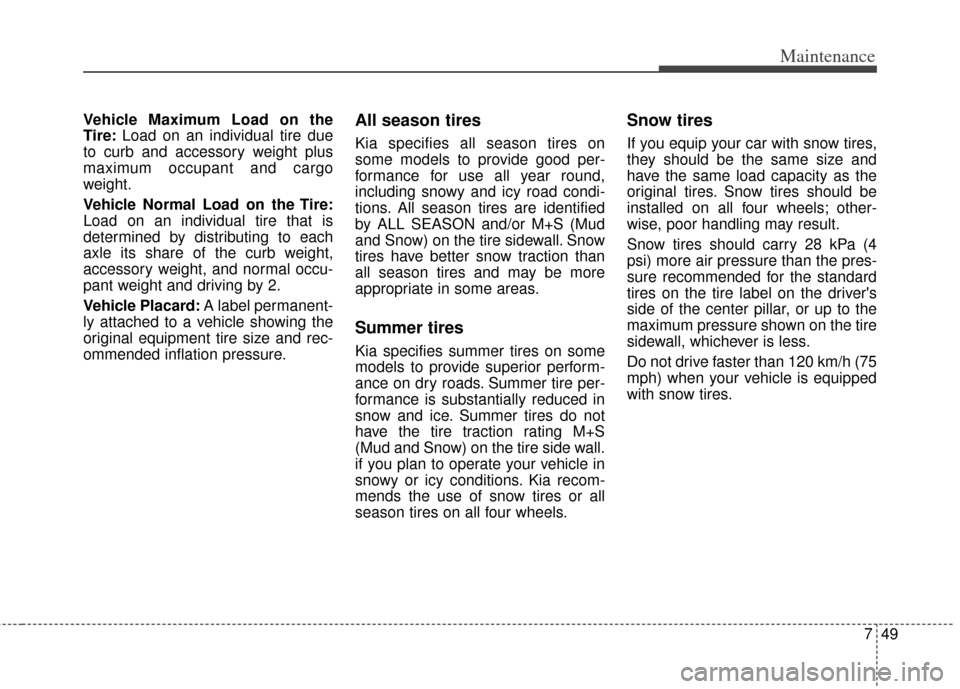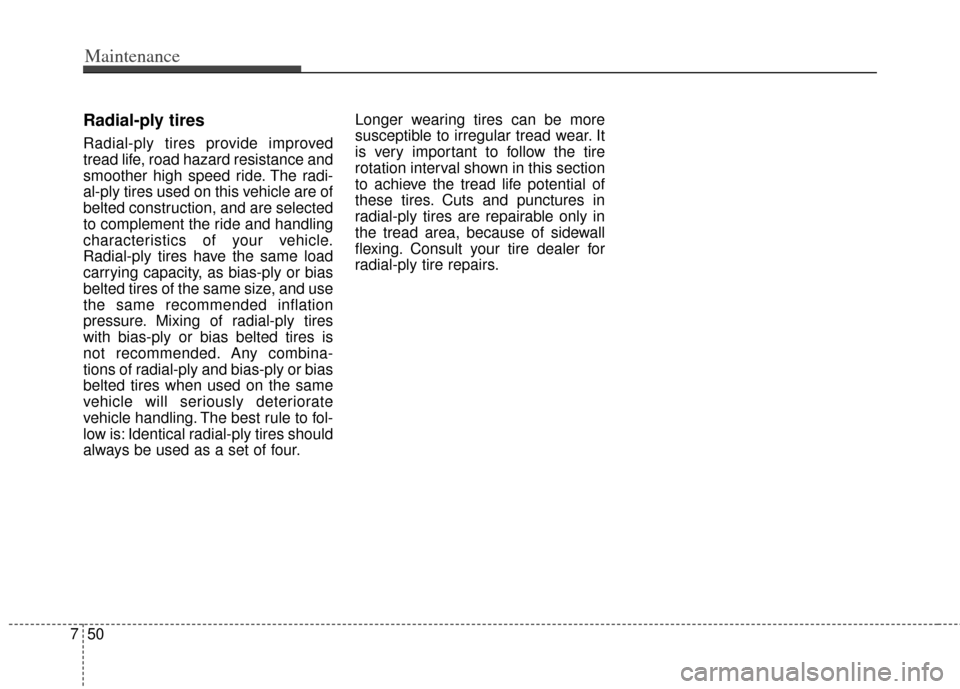2011 KIA Optima Hybrid inflation pressure
[x] Cancel search: inflation pressurePage 333 of 394

Maintenance
40
7
Remove the valve cap from the tire
valve stem. Press the tire gage firm-
ly onto the valve to get a pressure
measurement. If the cold tire inflation
pressure matches the recommended
pressure on the tire and loading
information label, no further adjust-
ment is necessary. If the pressure is
low, add air until you reach the rec-
ommended amount.
If you overfill the tire, release air by
pushing on the metal stem in the
center of the tire valve. Recheck the
tire pressure with the tire gage. Be
sure to put the valve caps back on
the valve stems. They help prevent
leaks by keeping out dirt and mois-
ture. Inspect your tires frequently for
proper inflation as well as wear and
damage. Always use a tire pres-
sure gauge.
Tires with too much or too little pressure wear unevenly causing
poor handling, loss of vehicle con-
trol, and sudden tire failure leading
to accidents, injuries, and even
death. The recommended cold tire
pressure for your vehicle can be
found in this manual and on the tire
label located on the driver's side
center pillar.
Remember to check the pressure of your spare tire. Kia recommends
that you check the spare every
time you check the pressure of the
other tires on your vehicle.Tire rotation
To equalize tread wear, it is recom-
mended that the tires be rotated
every 12,000 km (7,500 miles) or
sooner if irregular wear develops.
During rotation, check the tires for
correct balance.
When rotating tires, check for uneven
wear and damage. Abnormal wear is
usually caused by incorrect tire pres-
sure, improper wheel alignment, out-
of-balance wheels, severe braking or
severe cornering. Look for bumps or
bulges in the tread or side of tire.
Replace the tire if you find either of
these conditions. Replace the tire if
fabric or cord is visible. After rotation,
be sure to bring the front and rear tire
pressures to specification and check
lug nut tightness.
Refer to “Tire and wheels” in section
8.
Page 338 of 394

745
Maintenance
3. Checking tire life (TIN : TireIdentification Number)
Any tires that are over 6 years old,
based on the manufacturing date,
(including the spare tire) should be
replaced by new ones. You can find
the manufacturing date on the tire
sidewall (possibly on the inside of the
wheel), displaying the DOT Code.
The DOT Code is a series of num-
bers on a tire consisting of numbers
and English letters. The manufactur-
ing date is designated by the last four
digits (characters) of the DOT code.
DOT : XXXX XXXX OOOO
The front part of the DOT means a
plant code number, tire size and
tread pattern and the last four num-
bers indicate week and year manu-
factured.
For example:
DOT XXXX XXXX 1609 represents
that the tire was produced in the 16th
week of 2009.
4. Tire ply composition and mate-rial
The number of layers or plies of rub-
ber-coated fabric in the tire. Tire
manufacturers also must indicate the
materials in the tire, which include
steel, nylon, polyester, and others.
The letter "R" means radial ply con-
struction; the letter "D" means diago-
nal or bias ply construction; and the
letter "B" means belted-bias ply con-
struction.
5. Maximum permissible inflationpressure
This number is the greatest amount
of air pressure that should be put in
the tire. Do not exceed the maximum
permissible inflation pressure. Refer
to the Tire and Loading Information
label for recommended inflation
pressure.
6. Maximum load rating
This number indicates the maximum
load in kilograms and pounds that
can be carried by the tire. When
replacing the tires on the vehicle,
always use a tire that has the same
load rating as the factory installed
tire.
WARNING - Tire age
Replace tires within the recom-
mended time frame. Failure to
replace tires as recommended
can result in sudden tire failure,
which could lead to a loss of
control and an accident.
Page 341 of 394

Maintenance
48
7
Intended Outboard Sidewall: The
side of an asymmetrical tire, that
must always face outward when
mounted on a vehicle.
Kilopascal (kPa): The metric unit for
air pressure.
Load Index: An assigned number
ranging from 1 to 279 that corre-
sponds to the load carrying capacity
of a tire.
Maximum Inflation Pressure: The
maximum air pressure to which a
cold tire may be inflated. The maxi-
mum air pressure is molded onto the
sidewall.
Maximum Load Rating: The load
rating for a tire at the maximum per-
missible inflation pressure for that
tire.
Maximum Loaded Vehicle Weight:
The sum of curb weight; accessory
weight; vehicle capacity weight; and
production options weight.
Normal Occupant Weight: The
number of occupants a vehicle is
designed to seat multiplied by 68 kg
(150 pounds). Occupant Distribution:
Designated
seating positions.
Outward Facing Sidewall: The side
of a asymmetrical tire that has a par-
ticular side that faces outward when
mounted on a vehicle. The outward
facing sidewall bears white lettering
or bears manufacturer, brand, and/or
model name molding that is higher or
deeper than the same moldings on
the inner facing sidewall.
Passenger (P-Metric) Tire: A tire
used on passenger cars and some
light duty trucks and multipurpose
vehicles.
Recommended Inflation Pressure:
Vehicle manufacturer's recommend-
ed tire inflation pressure and shown
on the tire placard.
Radial Ply Tire: A pneumatic tire in
which the ply cords that extend to the
beads are laid at 90 degrees to the
centerline of the tread.
Rim: A metal support for a tire and
upon which the tire beads are seat-
ed.
Sidewall: The portion of a tire
between the tread and the bead. Speed Rating:
An alphanumeric
code assigned to a tire indicating the
maximum speed at which a tire can
operate.
Traction: The friction between the
tire and the road surface. The
amount of grip provided.
Tread: The portion of a tire that
comes into contact with the road.
Treadwear Indicators: Narrow
bands, sometimes called "wear
bars," that show across the tread of a
tire when only 2/32 inch of tread
remains.
UTQGS: Uniform Tire Quality
Grading Standards, a tire information
system that provides consumers with
ratings for a tire's traction, tempera-
ture and treadwear. Ratings are
determined by tire manufacturers
using government testing proce-
dures. The ratings are molded into
the sidewall of the tire.
Vehicle Capacity Weight: The num-
ber of designated seating positions
multiplied by 68 kg (150 lbs.) plus the
rated cargo and luggage load.
Page 342 of 394

749
Maintenance
Vehicle Maximum Load on the
Tire:Load on an individual tire due
to curb and accessory weight plus
maximum occupant and cargo
weight.
Vehicle Normal Load on the Tire:
Load on an individual tire that is
determined by distributing to each
axle its share of the curb weight,
accessory weight, and normal occu-
pant weight and driving by 2.
Vehicle Placard: A label permanent-
ly attached to a vehicle showing the
original equipment tire size and rec-
ommended inflation pressure.All season tires
Kia specifies all season tires on
some models to provide good per-
formance for use all year round,
including snowy and icy road condi-
tions. All season tires are identified
by ALL SEASON and/or M+S (Mud
and Snow) on the tire sidewall. Snow
tires have better snow traction than
all season tires and may be more
appropriate in some areas.
Summer tires
Kia specifies summer tires on some
models to provide superior perform-
ance on dry roads. Summer tire per-
formance is substantially reduced in
snow and ice. Summer tires do not
have the tire traction rating M+S
(Mud and Snow) on the tire side wall.
if you plan to operate your vehicle in
snowy or icy conditions. Kia recom-
mends the use of snow tires or all
season tires on all four wheels.
Snow tires
If you equip your car with snow tires,
they should be the same size and
have the same load capacity as the
original tires. Snow tires should be
installed on all four wheels; other-
wise, poor handling may result.
Snow tires should carry 28 kPa (4
psi) more air pressure than the pres-
sure recommended for the standard
tires on the tire label on the driver's
side of the center pillar, or up to the
maximum pressure shown on the tire
sidewall, whichever is less.
Do not drive faster than 120 km/h (75
mph) when your vehicle is equipped
with snow tires.
Page 343 of 394

Maintenance
50
7
Radial-ply tires
Radial-ply tires provide improved
tread life, road hazard resistance and
smoother high speed ride. The radi-
al-ply tires used on this vehicle are of
belted construction, and are selected
to complement the ride and handling
characteristics of your vehicle.
Radial-ply tires have the same load
carrying capacity, as bias-ply or bias
belted tires of the same size, and use
the same recommended inflation
pressure. Mixing of radial-ply tires
with bias-ply or bias belted tires is
not recommended. Any combina-
tions of radial-ply and bias-ply or bias
belted tires when used on the same
vehicle will seriously deteriorate
vehicle handling. The best rule to fol-
low is: Identical radial-ply tires should
always be used as a set of four. Longer wearing tires can be more
susceptible to irregular tread wear. It
is very important to follow the tire
rotation interval shown in this section
to achieve the tread life potential of
these tires. Cuts and punctures in
radial-ply tires are repairable only in
the tread area, because of sidewall
flexing. Consult your tire dealer for
radial-ply tire repairs.
Page 367 of 394

Specifications, Consumer information, Reporting safety defects
48
TIRES AND WHEELS
CAUTION
When replacing tires, use the samesize originally supplied with thevehicle.
Using tires of a different size candamage the related parts or make itwork irregularly.
Inflation pressure
psi (kPa)
Front Rear Front Rear
P205/65R16 94H 6.5J×16 235 (34) 235 (34) 235 (34) 235 (34) P215/55R17 93V 6.5J×17 235 (34) 235 (34) 235 (34) 235 (34)
T125/80D16 97M 4.0T×16 420 420 420 420
(60) (60) (60) (60)
Full size tire
Compact
spare tire *
2
Wheel lug nut torque
lb•ft (kg N
9~11
(65~79, 88~107)
Item
Tire
size Wheel size
Normal load *
1Maximum load
*
1Normal load : Up to 3 persons
Page 388 of 394

I3
Index
Camera (Rear view) ··················\
··················\
··················\
·4-84
Capacities (Lubricants) ··················\
··················\
················8-5
Capacity/weight ··················\
··················\
··················\
·········8-2
CareExterior care ··················\
··················\
··················\
··········7-61
Interior care ··················\
··················\
··················\
···········7-66
Tire care ··················\
··················\
··················\
················7-38
Cargo weight ··················\
··················\
··················\
············5-45
Center console storage ··················\
··················\
·············4-111
Central door lock switch··················\
··················\
············4-14
Certification label ··················\
··················\
··················\
····5-43
Certification label ··················\
··················\
··················\
······8-7
Changing tires (with spare tire) ··················\
··················\
·6-13
Checking tire inflation pressure··················\
··················\
·7-39
Child restraint system ··················\
··················\
················3-27 Lower anchor system··················\
··················\
···············3-31
Seat belt ··················\
··················\
··················\
·················3-16\
Tether anchor system ··················\
··················\
···············3-30
Child-protector rear door lock ··················\
··················\
···4-15
Climate control air filter ··················\
··················\
·4-106, 7-31
Clock (Digital) ··················\
··················\
··················\
·······4-115
Clothes hanger ··················\
··················\
··················\
·······4-115
Combined instrument, see instrument cluster ···············4-47
Compact spare tire (with spare tire) ··················\
············6-19
Compact spare tire replacement ··················\
··················\
7-42
Coolant ··················\
··················\
··················\
··················\
···7-24 Cooling fluid, see engine coolant ··················\
················7-24
Crankcase emission control system ··················\
·············7-68
Cruise control system ··················\
··················\
················5-27
Cup holder ··················\
··················\
··················\
·············4-113
Curtain air bag ··················\
··················\
··················\
·········3-49
Dashboard illumination, see instrument panel
illumination··················\
··················\
··················\
············4-47
Dashboard, see instrument cluster ··················\
···············4-47
Defogging (Windshield) ··················\
··················\
··········4-108
Defogging logic (Windshield) ··················\
··················\
·4-109
Defroster (Rear window) ··················\
··················\
···········4-96
Defrosting (Windshield) ··················\
··················\
··········4-108
Digital clock··················\
··················\
··················\
···········4-115
Dimensions ··················\
··················\
··················\
················8-3
Display illumination, see instrument panel illumination··················\
··················\
··················\
············4-47
Displays, see instrument cluster ··················\
··················\
4-47
Door locks··················\
··················\
··················\
················4-12 Central door lock switch ··················\
··················\
·········4-14
Child-protector rear door lock ··················\
··················\
·4-15
Drinks holders, see cup holders··················\
·················4-11\
3
Driver's 3-point system with evergency locking retractor··················\
··················\
··················\
··················\
3-18
Driver's air bag··················\
··················\
··················\
·········3-45
Driving at night ··················\
··················\
··················\
········5-34
C
D
Page 392 of 394

I7
Index
Neck restraints, see headrest ··················\
················3-8, 3-13
Occupant Detection System··················\
··················\
·······3-40
Odometer ··················\
··················\
··················\
·················4-48\
Oil (Engine) ··················\
··················\
··················\
·············7-22
Outside rearview mirror··················\
··················\
·············4-44
Overheats ··················\
··················\
··················\
··················\
·6-7
Owner maintenance ··················\
··················\
··················\
···7-5
Panorama sunroof ··················\
··················\
··················\
····4-28
Parking brake ··················\
··················\
··················\
···········5-16
Parking brake inspect··················\
··················\
·················7-29\
Passenger's front air bag ··················\
··················\
············3-45
Power brakes ··················\
··················\
··················\
············5-14
Power outlet ··················\
··················\
··················\
···········4-114
Power window lock button ··················\
··················\
······· 4-23
Pre-tensioner seat belt··················\
··················\
················3-21
Push starting··················\
··················\
··················\
···············6-6Rear seat··················\
··················\
··················\
··················\
·3-13
Rear view camera ··················\
··················\
··················\
····4-84
Recommended cold tire inflation pressures ··················\
7-38
Recommended lubricants and capacities ··················\
·······8-5
Recommended SAE viscosity number ··················\
········8-6
Road warning ··················\
··················\
··················\
·············6-2
Rocking the vehicle ··················\
··················\
··················\
·5-33
Scheduled maintenance service ··················\
··················\
···7-7 Maintenance under severe usage conditions ···············7-18
Normal maintenance schedule··················\
··················\
···7-8
Seat belt warning ··················\
··················\
··················\
·····3-17
Seat belts ··················\
··················\
··················\
··················\
3-16 Driver's 3-point system with evergency locking retractor ··················\
··················\
··················\
··············3-18
Front passenger and rear seat 3-point system with combination locking retractor ··················\
················3-19
Hight adjustment ··················\
··················\
··················\
···3-19
Pre-tensioner seat belt ··················\
··················\
·············3-21
Seat belt warning ··················\
··················\
··················\
···3-17
Seat belts hight adjustment ··················\
··················\
········3-19
Seat warmer ··················\
··················\
··················\
···············3-9
Seatback pocket ··················\
··················\
··················\
·······3-12
N
O
P
R
S